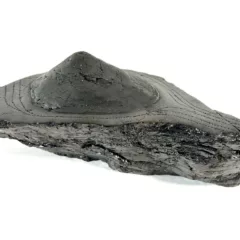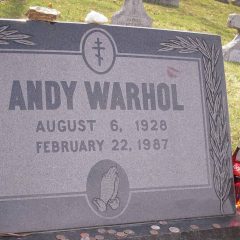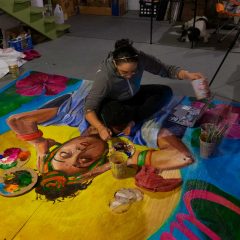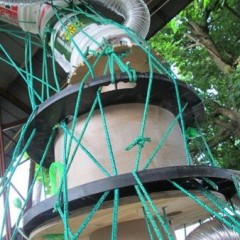—>Elizabeth visits a show in Mechanicsburg, PA, with work by self taught and outsider artists. —the Artblog editors——————–>
Thanks in part to TV programs like Antiques Roadshow and American Pickers, collectors are waking up to the value of found object art. With materials sourced from defunct factories, trash piles, flea markets and farms, the works — often made by self-taught, visionary and outsider artists — have found an audience far from the urban centers, in places like Trash Art Gallery on Main Street in Mechanicsburg, PA, where the current show Field of Vision brought together artists of the Metropolis Collective and collectors from New York, New Jersey, Kentucky, Georgia, North Carolina, Maryland and Pennsylvania for an exhibition whose opening was a boisterous night of networking.
Like me, Danielle Charette, who manages Metropolis Collective and Trash Art Gallery, hails from the area, and after two decades in NYC she’s back, showcasing local, as well as nationally- and internationally-known artists. Located near Interstates 81, 76 and 83, Trash Art Gallery’s reach extends deep into both the northern and southern states.
Organizations like the Metropolis Collective, which works with living artists in a respectful manner, are rewriting the history of urban galleries that exploited self-taught artists. Happily, many outsider artists are now more empowered than they once were. Helped by the Internet and social media, they can manage their own works, network, and feel a sense of belonging. The Web is helping to foster and broaden the careers of artists who were formerly hidden in poor or rural places.
It is notable that Charette herself is an outsider. She creates her own folk art paintings that mix the Pennsylvania Dutch Distelfink style with Mexican “Day of the Dead” themes; and she plants the Outsider flag many miles beyond the established urban, self-taught artist market.
Field of Vision features 18 artists working in many materials and styles, including found object sculpture, painting and conceptual art. Here’s a peek at some of the works and their creators.
The Found
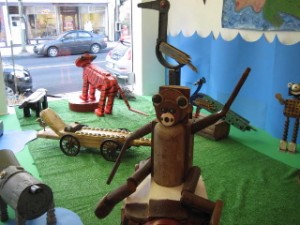
photo Matthew Crain.
Mark May helped curate the show and creates a circus atmosphere by filling the storefront window with animals made from wooden steel-casting forms. From Reading, PA, he was a fan and collector before he started making his own work, which connects African ceremonial sculpture and Pennsylvania PowWow folk medicine. May saves unique pieces of wood and metal until he decides their destiny, screws or nails things together, and makes fierce but playful personalities with bottle cap eyes and crimped metal teeth. Turned furniture parts and banisters become legs and arms on wood block bodies decorated with metal gears, hardware, handles and plastic dice.
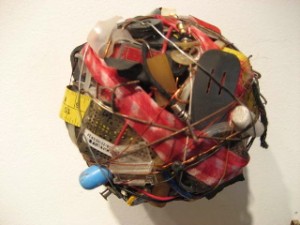
photo Matthew Crain.
Baltimore artist Don Edwards fashions animals and “junkballs” from rescued materials bound together with string. His approach is the obvious solution to the Great Plastic Island problem in the Pacific.
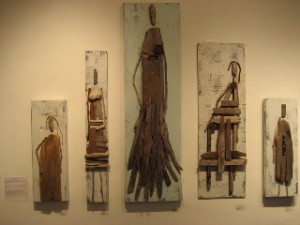
found objects, driftwood. photo Matthew Crain.
Amy Lansburg composes quiet, still, figurative totems out of driftwood from Lake Superior. Using spare shapes, neutral tones and weather-beaten wood, her work reminds me of Susan Rothenberg and Deborah Butterfield, notably in her use of material and subject, and her sense of animation.
The Painters
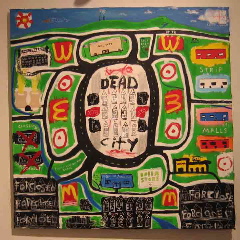
x 32″. photo Matthew Crain.
Dave “Big Dutch” Nally makes art by day and works the swing shift at a steel mill by night. Filtering his own cynical, stream-of-consciousness bullet points about pharmaceutical companies, and current events through a colorful and well-composed Basquiat-like style, Nally’s paintings could easily be mistaken for those of a hip, young artist with a Big Art Career. Standing beside the artist and his work lays bare a staple of outsider art: the artist’s compulsion to consider every detail equally, every color choice and every thought as being important. I’m humbled, feeling I’ve interrupted best friends in mid-conversation.
Matt Deterior feels like he’s almost “drowning in ideas,” since there’s so much to communicate as he follows his own train of thought. His paintings concoct a story from scratchy automatic writing, dual modernist-looking figures, and references to TV, lotteries, and dreams. Blank territories on the canvas are rare, and you can almost feel him deciding to restrain himself or edit.
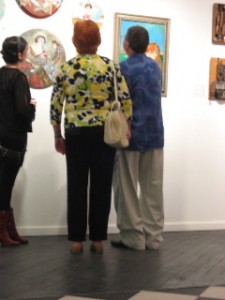
x16″. photo Matthew Crain.
Alison Silva paints saints, ghosts, auras, extra-terrestrials, mermaids, and herself, mingling qualities of all these sensitive subjects into multiple female portraits. Aware of her art historical influences– Marc Chagall, Leonore Carrington, Frida Kahlo, Gustav Klimt– Silva follows the lead of fluid, patterned, visual rhythms, likening the process to keeping pace with music.
The Conceptual Outsider

Narrating the important moment when strangers or friends upload images of his free art work makes Brent Leopold a.k.a. Human Artist Vending Machine very proud. A member of the International Union of Mail Artists, a large presence on the Web, Leopold sends his delicate watercolors of guns, figures and animals to anyone and everyone all the time. Leopold lives in Camp Hill, PA, so getting his work out there and his what-the-hell-let’s-see-what-happens attitude takes him way beyond the barriers I had associated with central Pennsylvania, making me see that these are outdated fictions. Now that art worlds are borderless, anyone with a computer can have an audience.
Field of Vision directs my attention to the future, where artists outside the academy and blue chip galleries have a distinct edge: compulsiveness, repetition and laser-focus blend seamlessly with technology.
The artists participating in Field of Vision (up through August 30th) include: Ross Brodar, Danielle Charette, “Rolo” Cooney, Matt Deterior, Donald Edwards, Dion Hitchings, Chris Cash Hogan, Bob Justin, Amy Lansburg, Charles M. Laster, Grace Kelly Laster, Peter “Bongo” Loose, Mark May, David “Big Dutch” Nally, Cher Shaffer, Alison Silva, Miz Thang, and Human Artist Vending Machine.
I highly recommend this show; it’s the biggest treat in town save Rakestraw’s Ice Cream.


